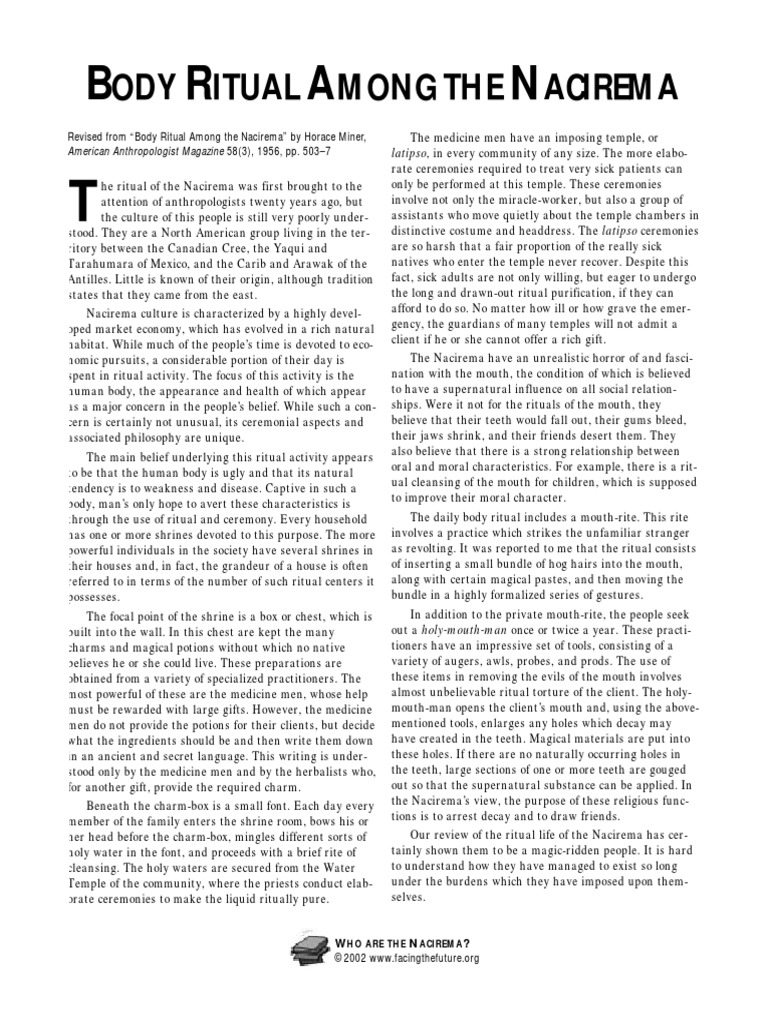The Nacirema shrine room presents a fascinating exploration of rituals and beliefs that intrigue anthropologists and social scientists alike. Imagine a space where the intricate interplay of culture, tradition, and daily life manifests; this is precisely what the shrine room encapsulates. In the modern parlance of anthropological study, the Nacirema provide a unique lens through which to examine our own societal behaviors and values. But why, you may wonder, does this seemingly obscure topic deserve our attention? What challenge does it pose to our understanding of human behavior and culture?
The Nacirema, an anthropological construct often used to critique the way we view cultures versus our own, illustrates a society imbued with rituals centered around the body and health. At the heart of this discussion lies the shrine room, a pivotal space where the Nacirema engage in various daily and periodic rituals aimed at physical and spiritual wellbeing. This room becomes an emblem of their cultural identity, showcasing their peculiar relationship with wellness.
Upon entering a Nacirema shrine room, a visitor would notice an array of artifacts and paraphernalia. Objects such as ornate wooden boxes filled with various substances, sacred tools made from refined materials, and mirrors crafted to reflect their ideals adorn the walls. Each item not only serves a utilitarian purpose but also conveys deeper meaning, reflecting the Nacirema’s archetype of health and beauty. This element of ritualistic maintenance of the body invites us to ponder our own propensity for nudging the limits of beauty as defined by society.
A notable aspect of the shrine room is the elaborate care taken by the Nacirema in their grooming rituals. Across the room, one could witness individuals performing various ceremonies involving sacred powders and potions applied to their bodies. It raises the question: what societal constructs dictate our own grooming and beautification behaviors? In our pursuit of an ideal image, do we not mirror the Nacirema’s practices in our own unique fashion?
The juxtaposition of hallowed rituals and everyday life provides a rich tableau for examining the intrinsic values within the Nacirema culture. Their unabashed devotion to bodily care offers a glimpse into their collective psychological ethos, reflecting a culture that venerates aesthetics and physicality. Yet, as one examines these practices, a challenge emerges—can we parse out the essential rites from mere vanity? Separating the two becomes a task of significant importance. In our world, consumerism often blurs the line between health-conscious decisions and superficial indulgences. What, therefore, distinguishes the two?
One must also consider the role of the shrine itself, as a purposed space that not only serves personal rituals but also acts as a communal nexus. Gathering in these shrine rooms fosters social cohesion and reinforces shared values. For the Nacirema, these gatherings symbolize both individual commitment to cultural practices and collective responsibility towards community wellness. In a modern context, how do we facilitate these communal experiences? And what joys and challenges do shared rituals bring to our lives?
The Nacirema meticulously curate their shrine rooms, continually amenable to the latest innovations or trends that may augment their ritual practices. Here lies the core of a salient question: as societal ideals evolve, do we find ourselves mere custodians of outdated rituals, or do we embrace change yet remain anchored to the foundational principles that define our well-being? The tension between tradition and modernity offers fertile ground for introspection. What rituals ought to be preserved, and which should be reimagined to embrace contemporary values?
Delving deeper into the shrine room’s ambiance, one notes the usage of incantations—expressions of reverence and petitions to unseen forces guiding the Nacirema’s health. Rituals involve repeating phrases that transcend simple communication, reflecting their belief in metaphysical interconnectedness. This practice mirrors our own engagement with spirituality and mindfulness. It nudges a query: in an increasingly secular age, how do practices involving enchantments resonate with our own pursuit of peace and tranquility? What, if anything, fills the void left by a waning belief in traditional supernatural interpretations?
Moreover, the importance of the curator—the individual responsible for maintaining the shrine—merits attention. These figures symbolize the society’s commitment to wellness, meticulously ensuring that traditional practices are preserved and respected. However, they also respond to the dynamic nature of culture, often adapting practices to the contemporary milieu. It begs the question of how we might recalibrate the guardians of our health and spirituality in the pursuit of collective well-being.
In summary, the Nacirema shrine room stands as a microcosm of a wider culture, encapsulating the complex relationship between tradition, body, and spiritual health. It invites us not only to reflect on the eccentricities of its rituals but challenges us to scrutinize our own. As we observe the Nacirema maintaining their rituals with reverence, we are compelled to discuss the relevance of our own practices in the context of shifting societal paradigms. Where will we find our balance between honoring time-tested customs and embracing transformative change? This dialogue, quite essential in an ever-evolving world, extends beyond the shrine room, beckoning us to ponder the underlying themes of culture, health, and identity in our own lives.
